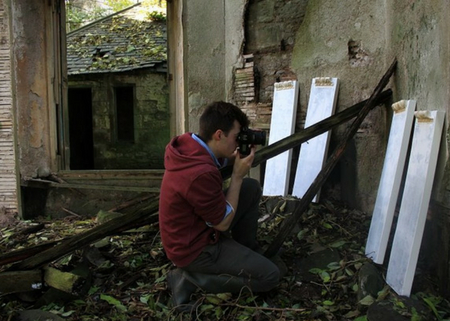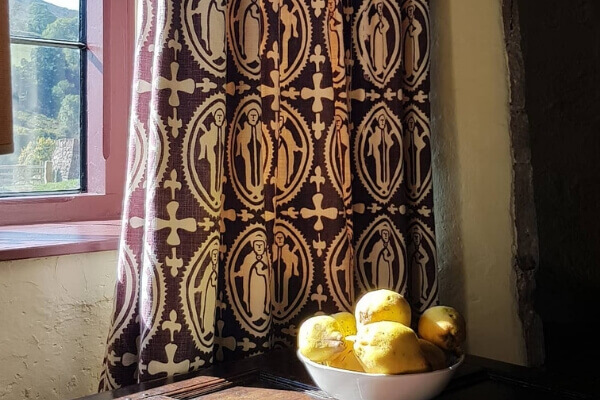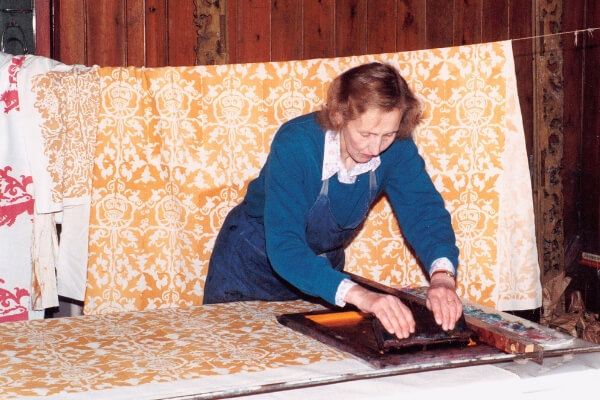 What is your role at Landmark?
What is your role at Landmark?
My primary role at Landmark is as Properties Assistant for the South region. I support the Regional Property Manager and our Housekeepers in the day-to-day running of 26 properties between Tewkesbury, Oxford, Southampton and Exeter.
What was your role at Llwyn Celyn?
At Llwyn Celyn I became involved with the furnishings team through the design and production of bespoke screen printed curtains for the property. Those familiar with Landmark will know that this is a longstanding tradition within our interiors, established by our co-founder Christian Smith during the charity’s early years.
Finding it difficult to source suitable fabrics for her furnishing schemes, Lady Smith began hand-printing textiles with a motif designed for each individual building based on some element of its history or architecture. The resulting curtains lend a characteristically homespun aesthetic to the properties they hang in, and have become synonymous with Landmark and its approach to restoration. Recognising this craft as an integral part of our heritage as an organization, I became interested in drawing on my background in art & design to help continue the tradition in a manner very close to Lady Smith’s practice.
What are the curtain designs based off?
We have two designs at Llwyn Celyn. Given the surprisingly numerous windows in the house, it was thought that having a single pattern throughout may be over repetitive. Developing two also gave us the opportunity to distinguish between today’s living spaces, formerly the open hall and service rooms of the original hall house, and the new bedrooms, bathrooms and later additions of the kitchen and cider house.
The first design features representations of Priors of Llanthony, based on illustrations of historic wax seals found in two 19th Century books. One figure relates to Llanthony Prima, located further up the valley from Llwyn Celyn and on whose lands the house was originally built, while the other depicts a Prior of its daughter house, Llanthony Secunda near Gloucester. It was once thought that the construction of Llwyn Celyn was linked to the merger of these two religious houses in 1480, yet with the solar range and service end now dated to 1420 it is certain that this was an event the house witnessed from close quarters in its early history. With the possibility remaining that Llwyn Celyn was intended as a Prior’s house, this design offers a fitting indication of that theory.

Our second design also originates in Llanthony iconography, and depicts “a hand issuing out of the clouds… holding out a rod of holly…” a device of the Priory so described by an antiquarian in 1847. I discovered this at the Church of St Mary the Virgin at Bromsberrow, Gloucestershire, in the form of stained glass believed to have been removed from Llanthony Secunda following its Dissolution and incorporated into a window at Bromsberrow in 1781.
Its individual elements are inherently relevant to Llwyn Celyn too; ‘Llwyn Celyn’ meaning ‘holly bush’ and the hand of the Llanthony badge alluding to those forming the latches on the house’s 19th Century windows. My own interpretation of this motif is that the holly represents the entity of Llwyn Celyn, while the valiant hand embodies the resilience of its ancient fabric and Landmark’s nurturing grasp. In this sense, the design has become a true symbol for Llwyn Celyn’s future.
Describe the process of designing/printing the curtains
As with all design, the process begins with research. After initial visits to Llwyn Celyn I began looking into its history and soon the link with Llanthony Priory was established as a primary reference. I collected texts and documents relating to Llanthony, searching through old guidebooks and historic accounts to unearth some visual elements which could be utilized. Besides documentary research I also strive to enrich the design process through physical experience, and so visits to Llanthony Prima and Bromsberrow Church were key moments from which to draw inspiration.
Once the motifs were finalised and a repeat developed, the process of printing could begin. The technique is screen-printing; a delightfully simple practice which in its most basic form retains a strong element of the handmade. From old photographs of Lady Smith in her workshop at Shottesbrooke and through studying many of her own Landmark curtains, it became evident to me that her method was unpretentious in nature, and so I felt it important to keep my process as true to hers as possible. Therefore the fabric for Llwyn Celyn was printed small scale, using a 20”x24” screen as a single pattern block.
 Landmark Trust co-founder Lady Smith screen-printing curtains for Wortham Manor
Landmark Trust co-founder Lady Smith screen-printing curtains for Wortham Manor
The design can be applied to the screen by various methods. The one chosen involved tracing and painting the design by hand, using a drawing fluid which resists a blocking solution subsequently applied over the entire screen. Once dry the design is then washed out, allowing the screen block to remain as a stencil through which the ink can pass onto the fabric. Each curtain drop is printed individually by hand rather than as a continuous length, the screen being moved horizontally and vertically across the fabric to create the entire pattern. All alignment is done by eye, sometimes leading to idiosyncrasies which again typify Lady Smith’s original practice and lend character to the finished piece.
What was the biggest challenge at Llwyn Celyn?
By far the biggest challenge was determining an appropriate source to create a strong design for Llwyn Celyn. Having studied other Landmark curtains at length, I learned that the basis for each could variably be a historic image or symbol relating to the building, a seemingly imagined design to suit the property or allude to its former purpose, or a ready-made motif lifted directly from detail within the structure.
Examples of the latter appear at properties like Gurney Manor, where simple repetition of a plasterwork fleur-de-lis in its solar wing forms the curtain design, and Sackville House, where a painted wall pattern revealed during restoration was copied directly for printing. In this vein, some of my earlier designs for Llwyn Celyn used the forms of its carved medieval doorheads as a pattern but these were almost too simple and obvious to prove a satisfying representation of the house. With such little other decorative detail at Llwyn Celyn it became clear that greater experimentation informed by alternative sources would be required to develop a suitably significant design.
What is one thing that people may not know about Llwyn Celyn?
There are almost 100 metres of fabric in the curtains!
Do you have any advice for anyone wanting to enter the heritage industry?
Working in heritage was for me quite unplanned, but born of a longstanding passion for historic buildings. Through my own experiences, I would say it is important to be willing to join the industry at any level with this enthusiasm, especially within the charitable sector where a genuine love of the subject only enhances its rewarding nature. Other than that, be ready to follow an unpredictable and indeterminate path.
What is your favourite Landmark?
A near impossible question to answer! Having begun working for Landmark on the housekeeping team at Auchinleck House in Ayrshire, many of my first loves remain in the Scotland & North of England region which I explored ardently. Besides Auchinleck, which will always be very special to me, Coop House is a delightfully quintessential Landmark in an idyllic location where I could while away hours watching the flow of the River Esk from its bay window. Yet more sublime in their setting however are the Shore Cottages at Berriedale, which witness the meeting of land and sea in many shades of drama throughout the seasons. As yet, this is the one property to which I have felt compelled to return time and again, which probably says it all.